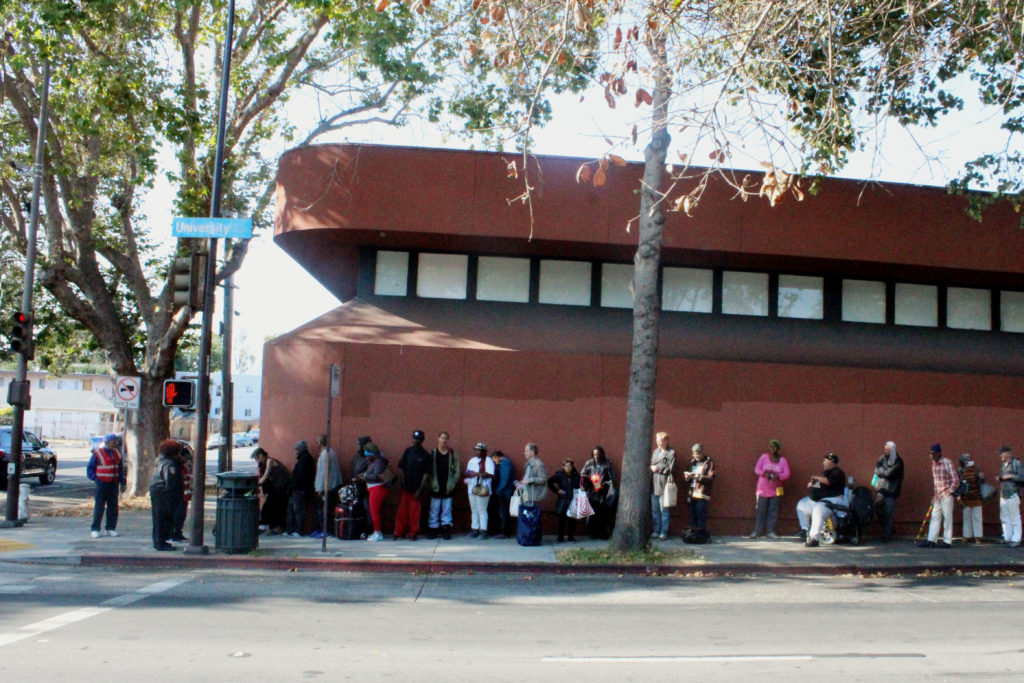
It’s 4:45 p.m., and people have started to gather across the street from the Berkeley Emergency Storm Shelter—the homeless shelter on the corner of University Avenue and Ninth Street. Because of complaints from neighbors about overcrowding, guests are not allowed to step foot outside the front door of the shelter until precisely 5:00. So instead, dozens wait on the adjacent corners in groups, each person hoping to be among the first in line to secure a bed for the night.
As the minutes creep by, tension builds. Some inch from the sidewalk to the street, and others yell that this creates an unfair advantage. When 5 o’clock finally strikes, a shelter monitor whistles. There is a mad dash across University Avenue. The first 17 people to jostle their way into line are guaranteed a bed for the night. On this particular evening in August, 18 people do not make the cut. They’re put on a waitlist.
“I have no idea where I’m going to go,” says Jonathan Utsey, 56. “I’ll charge up my wheelchair and I guess try to ride the bus all night long.”
Just a few weeks later, the Berkeley Emergency Storm Shelter (BESS) closed its doors at the Ninth Street location on August 31, because of fire code regulations. Operated by Dorothy Day House—a nonprofit that serves the homeless—the shelter provided beds for 90 people every night for eight months. (The majority of these beds were given out during a morning lottery, amongst the guests who stayed the night before.) Now, many of those people have been forced back onto the street. Like Utsey, most of them have nowhere to go.
In an eleventh hour decision on the morning of August 31, the city told Dorothy Day House employees that they had come up with a temporary new location for the shelter. Starting on September 1, guests will relocate to the North Berkeley Senior Center, at 1901 Hearst Avenue. After two weeks time, the shelter will move to the Frances Albrier Community Center—at 2800 Park Street—for another two week period.
for 60 beds, which will be given out through a need-based voucher system. They will be open between 7 p.m. and 7 a.m. Unlike the Ninth Street shelter, neither location will be able to provide meals or social services. After one month’s time, city officials say they will re-evaluate, and try to find a more permanent solution.
Since December, BESS has been the largest homeless shelter in Berkeley. This program grew from a 15-year-old contract with the city, through which Dorothy Day House has run an emergency storm shelter on nights that drop below 40 degrees, or reach a 30 percent chance of rain. However, on December 26, they opened up shop at the Ninth Street location seven days a week, rain or shine. Since opening, it has filled to capacity nearly every night, usually with a waitlist of 10 to 20 people. According to David Stegman, Dorothy Day House’s executive director, between 797 individual guests have stayed at least once in the past eight months. That’s over half of Berkeley’s homeless population, which by most counts numbers around 1,000.
So why is the shelter closing? According to the California fire code, buildings that are occupied for longer than 180 days need to undergo intensive safety procedures—a benchmark that the city surpassed long ago. Additionally, the Ninth Street site had previously been promised to the Berkeley Food Network, an organization that provides food and resources to people who might otherwise go hungry. Despite this, the shelter has extended its contract four times, as need demanded. This time, though, officials say the shelter must finally move.
“The City Council is very dedicated to keeping the shelter open, but we have to find a [new] location,” Berkeley Mayor Jesse Arreguín said at a town hall meeting about the shelter, on August 21. “There isn’t a lack of will, there’s a lack of location.”
On June 26, the Berkeley City Council set aside $400,000 for extending emergency shelter services. But advocates say the city could have done more to prevent this situation.
“The city manager has known this was coming for months and did nothing to plan for it. They’ve waited until the very last minute every time they’ve extended the contract,” says Susan Black, who lives across the street from the Ninth Street shelter, and is on the board of Dorothy Day House. “I’m speaking as a neighbor. There is no doubt in my mind that if the community hadn’t stepped up to the plate in the past three weeks, it would have just shut down.”
Although the shelter is not shutting down completely, many fear the city’s temporary solution will be inadequate. Because there will be 60 beds instead of 90, Dorothy Day House is using their master list of all the people who have stayed at the Ninth Street shelter to create a need-based voucher system. Need will be determined by things like age, amount of time on the street, and physical disabilities. The 60 highest-need people will be given vouchers, which will be required for entry at the new locations. If an individual does not use their voucher, Dorothy Day employees will take to the streets of Berkeley to try and find the next person on their list.
“At least 30 people are going to say ‘what about us?’ And we’re going to have to say ‘this is our new system, there’s nothing we can do about it,’” Stegman says.

Furthermore, while the Ninth Street shelter had storage space for 100 individuals, neither of the new locations will provide storage. This means that even those who do get vouchers will have to carry their belongings during the day, and those who are not awarded vouchers will be out both a place to sleep and a place to store their things.
As of this writing, the City of Berkeley has not responded to Street Spirit’s request for comment.
What’s happening on Ninth Street is a small example of a much larger phenomenon, and a problem that finding a new location for this particular shelter won’t fix.
“It’s the same reason that the homelessness condition exists to the extent that it does,” says Bob Whalen, the program manager at Dorothy Day House. “The high cost of housing and the high cost of property is also the reason that it is difficult to alleviate the root problem.”
The closure of the Ninth Street shelter is just one example of the ways in which these high costs hurt poor people: In a city that hardly has enough available space for the shelter, more permanent solutions—like affordable housing—are hard to come by.
“I’m diabetic, I’ve had a couple of strokes, I take 32 different pills just to survive. They’re supposed to find me a permanent bed,” Utsey said outside the shelter, referring to the affordable housing vouchers Berkeley gives to low-income people, with funding from the federal government’s Section 8 affordable housing subsidies. But permanent beds for homeless and low-income people are scarce. According to the U.S. Department of Housing and Urban Development data, those who received Section 8 tenant based vouchers between 2015 and 2016 waited an average of six years on the waiting list before becoming housed. In the meantime, many rely on the limited space in shelters like BESS for a safe, warm place to spend the night.
But over the past eight months, the Ninth Street shelter became more than just a place to spend the night: Many say it helps guests get back on track—off drugs and alcohol, onto an affordable housing waitlist, back into the workforce, or connected to the services they need.
“It’s like one big family here,” says Tysonia Tyson, 51. “It’s helped me get clean and sober. I don’t want to go back to the street. If I do that, I’ll relapse. I don’t want this to be my life.”
Advocates attribute the shelter’s success to its sense of permanency. Though it has only been open on a nightly basis for eight months, guests have been able to build a supportive community simply because it is open night after night. According to Stegman, 80 percent of the shelter’s guests come back to stay again. Additionally, Dorothy Day House employs 22 homeless people who act as shelter monitors. These monitors have a steady source of income and a place to eat and sleep each night.
“Obviously there’s a need to continue this on a year-round basis,” Stegman said. “The longer this gets put off, the harder it is for each aspect of this program to rebuild itself.”
Furthermore, Stegman and others worry it will be a while before guests actually believe that the Ninth Street shelter has closed. Like always guests will line up, but 5 o’clock will pass and nobody will be allowed inside.
“For the guests, we’ve told them for the last two extensions that we’re closing. And then we don’t, Stegman says. “So there are going to be a lot of people who come to Ninth Street, even though it closed.”
Alastair Boone is the Editor in Chief of Street Spirit.
Alastair Boone is the Director of Street Spirit.
